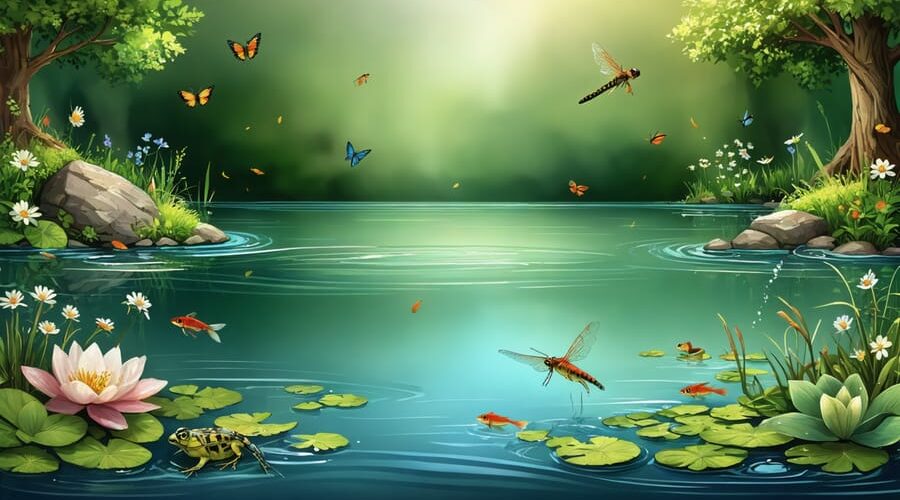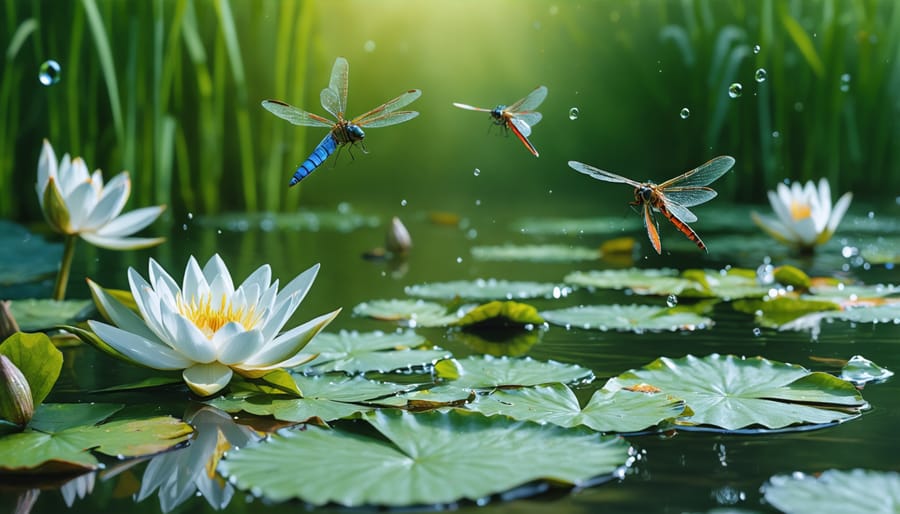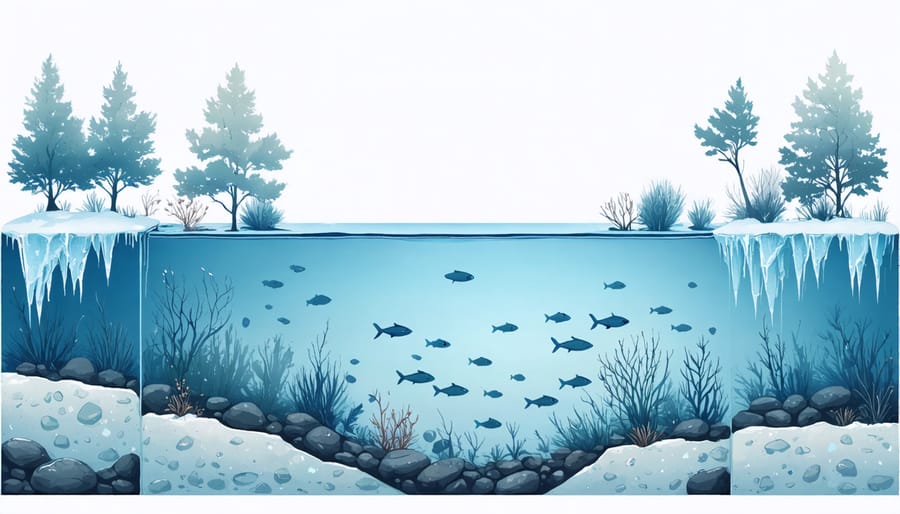
Your Pond’s Seasonal Symphony: How Wildlife Adapts Through the Year
A pond’s rhythmic seasonal changes create nature’s most captivating show, transforming from spring’s vibrant awakening to winter’s quiet dormancy. Building a healthy pond ecosystem means embracing these natural cycles, each bringing unique challenges and rewards. Spring bursts with new growth as aquatic plants emerge and fish become active, while summer’s warmth creates a bustling hub of dragonflies, frogs, and waterfowl. Autumn paints the water’s surface with fallen leaves, preparing pond life for winter’s approaching chill. During the cold months, life continues beneath the surface as fish slow their metabolism and beneficial bacteria maintain their essential work at a gentler pace. Understanding these seasonal shifts helps pond owners anticipate and adapt to their water garden’s changing needs, ensuring year-round beauty and vitality for both plants and wildlife.
Spring Awakening: Life Returns to Your Pond
Early Spring Migrants and Amphibians
As winter fades, your pond becomes a bustling hub of activity as early spring migrants return and amphibians emerge from their winter dormancy. Wood ducks and mallards are often among the first visitors, searching for nesting sites near the water’s edge. These beautiful waterfowl bring life and movement back to your pond, marking the start of the breeding season.
In late February to early March, you’ll begin to hear the distinctive calls of spring peepers and wood frogs, creating nature’s own symphony. These small amphibians are typically the first to emerge, followed by larger frogs and toads as temperatures consistently stay above freezing. The males’ chorus serves as a fascinating courtship ritual, attracting females to the pond for breeding.
Salamanders also make their annual migration to breeding pools during the first warm spring rains. If you’re lucky, you might spot them moving under the cover of darkness. Within weeks, you’ll notice strings of frog eggs and clusters of salamander eggs attached to underwater plants or resting on the pond bottom.
To support these early spring visitors, maintain some shallow areas in your pond and preserve natural vegetation around the edges. Avoid using chemicals or cleaning the pond too thoroughly during this crucial breeding period. The presence of these creatures isn’t just delightful to observe – they’re also indicators of a healthy pond ecosystem.

Spring Plant Growth and Water Chemistry
As spring temperatures rise, dormant aquatic plants burst into life, beginning their annual growth cycle. This awakening triggers fascinating changes in your pond’s water chemistry. New plant growth starts consuming nutrients that have accumulated over winter, particularly nitrogen and phosphorus, helping to naturally balance water conditions.
You’ll notice submerged plants developing fresh, bright green shoots, while marginal plants push up new growth from their root systems. This plant activity increases oxygen levels in the water through photosynthesis, creating better conditions for fish and other pond life. The improved oxygen levels also help beneficial bacteria become more active, supporting the pond’s natural filtration process.
Water clarity typically improves during this period as plants compete with algae for nutrients. However, you might experience a brief “spring bloom” of algae before your plants are fully established. Don’t worry – this is normal and usually clears up as plants mature and take up more nutrients.
Spring plant growth also helps stabilize water temperature by providing shade and shelter. As plants develop, they create essential hiding spots for spawning fish and emerging wildlife, while their roots help filter and purify the water. This natural cycle of growth and water chemistry changes sets the stage for a thriving pond ecosystem throughout the warmer months ahead.
Summer’s Peak Activity

Summer Wildlife Visitors
Summer brings an explosion of life to your pond, transforming it into a bustling hub of activity. Dragonflies and damselflies dart across the water’s surface, their iridescent wings catching the sunlight as they hunt for mosquitoes and other small insects. These beautiful aerial acrobats are not just decorative – they’re vital players in your pond’s ecosystem dynamics.
You’ll notice an increase in butterfly visitors too, especially around your marginal plants, while water striders skate gracefully across the surface. Bees and other pollinators become regular guests, attracted by your pond plants in full bloom.
Birds make your pond a favorite summer destination, with species like robins, finches, and warblers stopping by for a drink or quick bath. You might even spot herons or kingfishers if you’re lucky, though keep an eye on them if you have fish! Consider adding a shallow beach area or some partially submerged rocks to create safe access points for your feathered friends.
Mammals also become more active around your pond during summer. Hedgehogs might visit for a nighttime drink, while squirrels and even foxes may stop by to quench their thirst. You might notice more frog and toad activity too, as they take advantage of the warmer waters for breeding.
Remember that these summer visitors aren’t just passing through – they’re all contributing to your pond’s health and biodiversity. Each creature plays a unique role in maintaining the natural balance of your water garden.
Managing Summer Challenges
Summer brings unique challenges to pond maintenance, but with the right approach, you can keep your water garden thriving. Algae growth is perhaps the most common issue, especially during hot, sunny days. To combat this, aim to have about 60% of your pond’s surface covered with floating plants, which naturally compete with algae for nutrients and provide essential shade.
Maintaining proper oxygen levels becomes crucial as warm water holds less dissolved oxygen. Consider adding a fountain or waterfall if you don’t already have one – not only do they look beautiful, but they also help aerate the water. Keep an eye on your fish during hot spells, as they’ll need more oxygen when temperatures rise. If you notice them gasping at the surface, it’s time to boost aeration.
Regular maintenance becomes even more important in summer. Remove dead plant material promptly, as it decomposes faster in warm temperatures and can affect water quality. Check your pump and filter system weekly, as they work harder during this season. A well-maintained filter system helps keep water clear and healthy.
Water loss through evaporation is another summer challenge. Top up your pond when necessary, but do so gradually to avoid shocking your fish. Using a timer for your fountain can help reduce water loss – run it during cooler hours when evaporation is lower.
Remember to feed fish appropriately during summer. They’re more active and need more food, but be careful not to overfeed, as excess food can lead to water quality issues.
Autumn Transition
Fall Migration Patterns
As autumn approaches, pond owners witness one of nature’s most fascinating spectacles – the fall migration. Many pond visitors begin preparing for their seasonal journey, while year-round residents adjust their behaviors for the coming cold. Waterfowl like ducks and geese gather in larger groups, often using backyard ponds as temporary rest stops during their southward migration.
Fish become more active in fall, instinctively knowing they need to build up energy reserves for winter. You’ll notice them feeding more frequently, especially during warmer parts of the day. This is also when amphibians like frogs begin seeking out deeper water or protected areas where they can implement their winter survival strategies.
Insects display interesting patterns too. Dragonflies make their final appearances, while some aquatic insects move deeper into the pond bottom. Pond plants also prepare for winter, with marginal plants slowly dying back and water lilies drawing energy into their roots.
This transition period is crucial for pond wildlife. Some creatures, like turtles, begin slowing down their metabolism and searching for muddy areas to burrow. Others, like certain bird species, might stick around if your pond offers adequate shelter and food sources. Creating brush piles near your pond and maintaining some plant cover can help support both migrating and resident wildlife during this changing season.
Preparing Your Pond for Winter
As temperatures drop, preparing your pond for winter is crucial for protecting your aquatic friends. Start by removing fallen leaves and debris with a net before they sink and decompose. This simple step prevents harmful gases from building up under winter ice.
Next, trim back dying plants, leaving about 2 inches of growth above the water line. Hardy water lilies can stay in deep water, but tropical varieties should be brought indoors. If you have fish, gradually reduce feeding as water temperatures fall below 50°F (10°C), and stop completely when it hits 39°F (4°C).
Consider adding a pond net over the surface to catch falling leaves and protect from predators. For areas with harsh winters, install a de-icer or aerator to maintain a small opening in the ice, allowing toxic gases to escape and oxygen to enter. This breathing hole is essential for fish survival.
Don’t break ice that forms on the surface – the shock waves can harm your fish. Instead, place a hot pan on the ice to melt a small hole if needed. Add cold-weather beneficial bacteria to help break down organic matter throughout winter.
Finally, protect your pump and filter system. Either keep them running (if your pond doesn’t freeze solid) or remove, clean, and store them in a frost-free location. With these preparations, your pond and its inhabitants will be ready to weather the cold months ahead.
Winter’s Quiet Period
Life Beneath the Ice
While the surface of your pond may freeze over during winter, there’s a fascinating world of survival happening beneath the ice. Pond creatures have evolved remarkable strategies to endure the cold months, making the most of their chilly sanctuary.
Fish slow down their metabolism dramatically, entering a state similar to hibernation. They gather in deeper areas of the pond where the water temperature remains more stable, usually around 39°F (4°C). This deeper zone, known as the winter layer, provides a safe haven where they can conserve energy until spring arrives.
Frogs and turtles have their own clever tactics. Some frogs partially bury themselves in the mud at the bottom of the pond, while others actually allow their bodies to freeze partially while producing natural antifreeze compounds to protect their vital organs. Turtles reduce their heart rate to just a few beats per hour and can absorb enough oxygen through their skin to survive.
Insects display equally impressive adaptations. Some produce glycerol in their bodies, which works like antifreeze to prevent ice crystals from forming in their cells. Others create protective cocoons or find shelter in plant debris at the bottom of the pond.
Aquatic plants also prepare for winter, with many species dying back to their roots while storing energy for spring renewal. This decaying plant material continues to provide shelter and sustenance for the pond’s winter residents.

Supporting Winter Wildlife
During winter, your pond becomes a vital sanctuary for local wildlife, and there are several ways you can help these cold-weather visitors thrive. Keep a small area of your pond ice-free by using a floating de-icer or maintaining a running pump. This provides essential drinking water for birds and allows toxic gases to escape from the water.
Create wildlife-friendly zones around your pond by leaving fallen leaves and old plant stems in place. These natural shelters provide hiding spots for insects, amphibians, and small mammals. Consider placing a few logs or branches near the pond’s edge to create additional shelter opportunities.
Food becomes scarce in winter, so setting up bird feeders near your pond can make a significant difference. Choose feeders that offer a variety of foods like seeds, suet, and nuts. Position them where birds can quickly retreat to cover if needed, but avoid placing them directly over the water to prevent contamination.
If you have shallow areas in your pond, maintain them as they serve as important drinking spots for smaller animals. Consider adding a few flat rocks that rise slightly above the water level – these make perfect resting spots for birds and provide basking areas on warmer winter days.
Remember to move slowly and quietly when approaching your pond during winter, as wildlife may be using it as a refuge. Regular, gentle maintenance helps ensure your pond remains a welcoming habitat throughout the cold season.
Understanding and adapting to your pond’s seasonal changes is essential for maintaining a thriving aquatic ecosystem throughout the year. Just as nature follows its rhythms, your pond requires different types of care and attention as the seasons shift. By staying attentive to these natural cycles, you can create a more resilient and beautiful water feature that supports diverse wildlife and provides year-round enjoyment.
Remember that each season brings its own challenges and opportunities. From the awakening of spring to the dormancy of winter, your pond is constantly evolving. Regular maintenance, careful observation, and timely interventions will help you maintain proper water quality, support healthy plant growth, and create a welcoming habitat for fish and other aquatic creatures.
Don’t be afraid to adjust your maintenance routine as you learn more about your pond’s specific needs. Every pond is unique, and what works for one might not work for another. By staying engaged with your pond’s seasonal changes and responding appropriately, you’ll develop a deeper connection with your water garden and ensure its long-term health and beauty. Keep learning, stay observant, and enjoy watching your pond flourish through every season.
